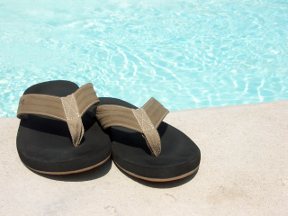Making Your Pool More Environmentally-Friendly
 Pools and other water features like fountains and ponds are pretty seriously inefficient when it comes to both electrical workings and water, so the most efficient thing to do is not have one. If you have one, instead of repairing it, maybe you should take it out and make it into a nice, sustainable xeriscaped yard or even a vegetable garden to feed your family. But OK, I get it, the Dallas concrete (or wherever you live) has created an urban heat island effect and you can't imagine not being able to cool off with a swim in your own backyard. So here are some suggestions to make your pool more efficient and better for the environment.
Pools and other water features like fountains and ponds are pretty seriously inefficient when it comes to both electrical workings and water, so the most efficient thing to do is not have one. If you have one, instead of repairing it, maybe you should take it out and make it into a nice, sustainable xeriscaped yard or even a vegetable garden to feed your family. But OK, I get it, the Dallas concrete (or wherever you live) has created an urban heat island effect and you can't imagine not being able to cool off with a swim in your own backyard. So here are some suggestions to make your pool more efficient and better for the environment.
Heating Your Pool More Efficiently
If you plan to heat your pool, solar heaters cut down (or if you are lucky) completely eliminate the use of natural gas or other fuel. But maybe you should just not swim when it’s cold. If you do heat the pool, use an insulated cover to keep the heat in when you’re not swimming.
Using Your Pool Pump More Efficiently
Standard pool pumps are single speed and big enough to pump at the highest flow rate when needed, including jets for your luxury spa. The problem is that this big, honking pump uses way more energy than it should because it probably doesn’t need to pump so much water most of the time it’s on. Be sure you put in a variable speed pump which will adjust to pump the amount of water needed, using less power in the process. Put your pump on a timer, too, so it only runs when you need it. Depending on how much swimming you do, your pool may work fine with the pump running 6-18 hours a day instead of full time. More energy saved!
To wrap up the pump discussion, the pipes that the water moves through should be as big a diameter as possible with really wide, sweeping turns. Small diameter pipes and tight turns put up a lot of resistance to the water flow, making the pump work harder, using more energy in the process. Those bigger pipes and wide turns can allow you to put in a smaller pump. More energy saved! Isn’t this easy?
Finally, think about using solar photovoltaic panels to run the pumps. I know I’ve said some mean things about solar panels, but since you’re spending boatloads of money on that fancy pool, you can fork over a little more to save energy running the pumps.
Switch to Salt-Water or Constructed Wetlands to Lessen Environmental Impact
These last ideas don’t exactly fall into the efficiency category, but are important in terms of environmental impact. For health and safety, freshwater swimming pools must be purified with added chlorine, a pretty nasty, toxic chemical. If you absolutely must have a pool, consider installing a saltwater pool, which generates chlorine from salt added to the water or through the filter equipment. Saltwater pools avoid the need to handle chlorine directly, though you do have to balance the water chemicals regularly. Pool chemicals can be corrosive to finishes and equipment, so regular maintenance and repairs are important.
Kind of like owning a boat – it requires a lot of maintenance and for some boat owners, their happiest days are the day they buy it and the day they sell it. This might apply to some pool owners as well.
A really cool alternative is a natural pool that is filtered by running the water through something called “constructed wetlands.” You may ask, “What is a constructed wetland?” Well, it’s a treatment system that sort of recreates a natural wetland using plants and soils to naturally filter the water. It can also be a landscape feature near the pool or farther away and hidden behind plants. The plants love to take in the impurities as your pool water is pumped through the constructed wetland, using them for nourishment and returning clean water to the pool. You need lots of extra space for these things, but they do lessen the need for chemicals and if done right, they look kind of cool.
Green building consultant Carl Seville writes for Networx.
Updated August 21, 2018.
Looking for a Pro? Call us (866) 441-6648

Landscaping Average Costs
Landscapers Experiences

Seamless Extension Of Concrete Patio And Poolside Retaining Wall

Yard Cleanup By A Local Landscaper Who Cares About Customers



